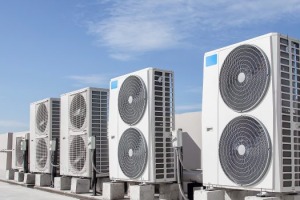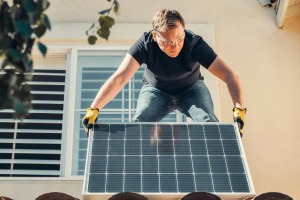


News I published 09 November 2023 I Reinier Zuydgeest
Why The Trend Towards More DIFM Reversed And DIY Is On The Rise
You can do a home improvement job in your house in two ways. You can either do it yourself or get someone to do it for you. For years, there has been a steady increase in the share of do-it-for-me (DIFM) jobs and a decline in do-it-yourself (DIY) jobs in the European home improvement market. But that trend has recently turned around.
Many recent changes in the home improvement market can be linked to the disturbing effects of the pandemic that we all experienced. Not least is the dramatic rise in home improvement projects done in 2020 and 2021. However, it would be too easy to blame the shift from increasing DIFM towards more DIY on Corona, as the results of USP Consultancy’s European Home Improvement Monitor show.
The trend broke before COVID
For nearly a decade, we have been monitoring the balance between do-it-yourself (DIY) jobs and do-it-for-me (DIFM) jobs in the European home improvement market. There used to be a slow and steady trend towards more DIFM and, consequently, a gradual decline in the share of DIY jobs. The reasons for this trend were various, but demographics played a major role.
As the population ages, older generations become less capable of doing the home improvement jobs that they used to do themselves. Meanwhile, the younger generation of consumers showed less interest in DIYing on average, resulting in a net decline in DIY jobs and an increase in DIFM. Meanwhile, the market situation was still accommodating in the sense that the labour shortage situation was not that pressing yet, making DIFM a more affordable option.
However, as our results show, the share of DIFM jobs reached its peak in 2018, after which it started to decline. Since then, the share of DIY jobs has steadily been on the rise and is still rising. It is important to note that in 2018 and 2019, there was no pandemic yet. Therefore, the coronavirus crisis cannot be blamed for turning the trend of DIFM versus DIY in the European home improvement market
COVID lockdowns may have acted as a catalyst, though
Although the pandemic may not have been the cause, we know it had a major impact on the home improvement market. More consumers were homebound due to coronavirus restrictions, and they could not spend money on going out or on holidays. That means they had more incentive, time, and budget to do home improvements.
The result was an increase in home improvement jobs done in the European market. Also, many people who would otherwise not do home improvement jobs themselves started doing some DIY jobs during the pandemic. Doing so, they gained some experience, and more confidence and they may have derived joy and pride from doing the jobs themselves.
We know there is a strong correlation between the level of DIY experience and the chances of a person doing home improvement jobs themselves instead of outsourcing them. Chances are high that people who started DIYing during the pandemic continued to do so. So, although the pandemic may not have caused the shift towards more DIY, it acted as a catalyst for that trend.
Labor shortages are the key factor
So if COVID did not cause the trend to break, what did? The dominant reason is that labour shortages started to become more pressing in the construction and renovation sectors in the years before the pandemic, resulting in higher labour costs. This caused many consumers to do home improvement jobs themselves, thereby saving labour costs and investing in materials instead. This included the older generation, who kept DIYing for longer than expected.
At our latest data point, at the end of 2022, we see that the trend towards more DIY is persisting. Meanwhile, labour shortages are an even greater issue than before the pandemic, and inflation and high material costs make consumers even more budget-conscious than before. That is why we expect consumers to continue saving on labour costs. That means the trend towards more DIY will continue, at least in the coming years, until the demographic factor catches up.
For a full overview of the trends and developments in the home improvement market in 11 European countries, we refer you to USP Consultancy’s European Home Improvement Monitor.

Read more about the subject


18 July 2024 I Dirk Hoogenboom
Willingness to invest of European consumers in sustainability improvements of their houses lower in 2024 than in 2023


02 July 2024 I Dirk Hoogenboom
BIM adoption among European HVAC installers remains low


06 June 2024 I Maja Markovic
Sustainability in the electrical installation sector; slow but steady growth


06 June 2024 I Dirk Hoogenboom
Trends in construction material usage

Fresh Insights Await
Our latest reports
Delve into the newest findings across various market segments, crafted for a cutting-edge overview. Explore our latest reports, brimming with up-to-date data, trend analyses, and in-depth examinations, all tailored to provide you with a comprehensive understanding of the current market dynamics.
Construction
Home Improvement
Installation
Construction
Trends in material usage Q1 2024
2024 102 pages
Explore the evolving trends in material usage among European architects in Q1 2024. Delve into the factors driving material preferences and the impact on construction aesthetics and sustainability.
1,850 Euro
Construction
Media orientation H2 2021
2024 161 pages
Explore the media engagement patterns of contractors to optimize your marketing strategies. Dive into a pool of insights that unveils how contractors interact with different media channels.
6,300 Euro
Construction
European Green Deal Q4 2021
2024 88 pages
Explore the impact and reception of the European Green Deal among architects. Understand how the initiative is influencing architectural practices and sustainability measures.
1,850 Euro
Construction
BIM Q4 2023
2024 246 pages
Key insights regarding the BIM usage and behaviour of European architects, and our latest future building volumes prognoses
1,850 Euro
Construction
Purchase Channels H2 2023
2024 123
Explore the buying and ordering behaviour among contractors in H1 2023. Uncover the key channels used, share-of-wallet and much more.
6,300 Euro
Construction
Behavioural segmentation and media usage report 2023
2023 75 pages
This report provides a comprehensive overview of purchase behaviour, products, and media usage, specifically focusing on European handymen. It delves into how handymen use media, and for what purposes, and examines their habits and preferences in terms of purchasing behaviour.
8,400 Euro
Home Improvement
DIY versus DIFM Q4 2021
2024 113 pages
This report is a must-have if you’re in the home improvement industry. It provides a wealth of information on the behaviour of DIY and DIFM consumers, their motivations, and the factors that influence their purchasing decisions.
3,150 Euro
Home Improvement
DIY or DIFM Q4 2023
2024 70
Explore the prevailing trends between DIY and DIFM in Q4 2023. Understand consumer preferences and the factors influencing their choice between DIY and DIFM.
3,150 Euro
Home Improvement
Branding Q3 2023
2023 93 pages
This report offers an extensive overview of the home improvement industry, with a focus on branding and the most popular brands within different categories. Within this report, you will gain insights into how customers perceive home improvement brands and what motivates them to buy certain products.
3,150 Euro
Home Improvement
Purchase channels Q2 2023
2023 114 pages
The European Home Improvement Monitor offers valuable insights on purchase channels in the European home improvement industry, examining the evolving preferences and behaviors of consumers across traditional retail and emerging online platforms.
3,150 Euros
Home Improvement
Purchase Channels Q2 2022
2022 124 pages
Uncover the prevalent purchase channels in the home improvement sector during Q2 2022. Delve into consumer preferences and the factors influencing their purchasing decisions.
3,150 Euro
Home Improvement
Do-it-yourself or do-it-for-me Q4 2022
2022 93 pages
Explore the prevailing trends between DIY and DIFM in Q4 2022. Understand consumer preferences and the factors influencing their choice between DIY and DIFM.
3,150 Euro
Installation
Smart & Connected Products Q2 2024
2024 120 pages
This report provides a comprehensive view of the attitudes of installers toward smart building solutions, specifically among electrical installers and their clients. In the report, you will find insights into the installers' experiences with installing smart products and the willingness of end users to invest in such solutions, as well as their motivations and pain points.
3,150 Euro
Installation
Sustainability Q1 2024
2024 81 pages
Delve into sustainability trends in the home improvement sector in Q1 2024. Discover consumer preferences and the shift towards eco-friendly home improvement solutions.
3,150 Euro
Installation
BIM Q1 2024
2024 84 pages
The European Mechanical Installation Monitor report provides a detailed analysis of the plumbing and HVAC industry. This report specifically focuses on BIM adaptation in the industry.
2,650 Euro
Installation
Sustainability Q1 2024
2024 99 pages
The European Electrical Installation Monitor report provides a detailed analysis of the sustainable solutions in the installation industry. This report specifically focuses on sustainability aspects in the industry.
3,150 Euro
Installation
Challenges toward sustainable future Q4 2021
2024 111 pages
2,650 Euro
Installation
Purchase channels Q4 2021
2024 106 pages
Delve into the training needs within the electrical installation sector. Understand the areas requiring skill development to meet the evolving demands of the industry.
3,150 Euro








